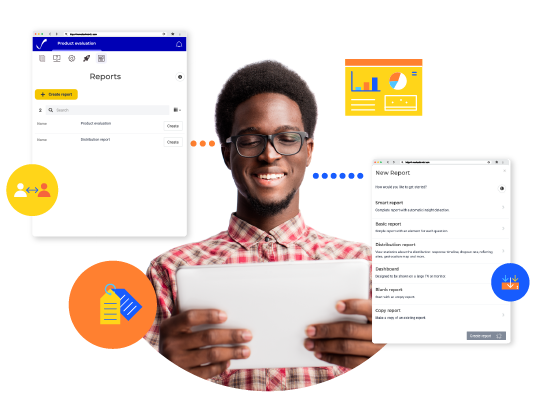Despite the persistent shift into a more digitalized and tracked world, ad hoc surveys continue to remain a tried-and-true method that provide businesses with invaluable information.
The goal of a survey varies depending on how the company intends to use the information. For example, the feedback collected in an employee satisfaction survey will be used differently than the data from a training evaluation survey.
The most common types of surveys businesses use include:
- Brand Awareness: Customer perception of the brand, including the name and logo, brand reputation, memorability, etc.
- Customer Satisfaction: Insight into customers’ experiences with your company, products, and services.
- Employee Satisfaction: Feedback about the work culture, job satisfaction, career development opportunities, morale, and areas for improvement.
- Event Evaluation: Follow-up to gauge the success of an event from the attendees’ perspective and help businesses plan future events based on the feedback.
- Exit Interview: Insight into what causes employees to leave the company, such as health benefits, financial incentives, growth opportunities, training, personality conflicts, scheduling issues, etc.
- Job Satisfaction: Similar to an employee satisfaction survey but targeted to specific roles within departments.
- Lead Generation: Contact information, interests, and preferences from a targeted audience.
- Market Research: Information about the market as a whole, customer demographics, industry positioning, product and pricing opportunities, etc.
- Training Evaluation: Opinions and general feedback about the quality of training, presentations, instructor evaluation, etc.
While the data collected in each type of survey is going to serve different goals and reveal many different aspects of a business, all of these surveys do have one thing in common – their results will be inaccurate if they use leading or loaded questions.
What is a Leading Question?
A leading question is phrased in a way meant to steer the respondent’s answer in a particular direction, often by implying that there is a correct answer, using suggestive language, or even including part of the answer in the question itself.
Leading questions are often set up as yes or no answers, or respondents are given a limited range of choices that may not be reflective of how they truly feel.
Example of a leading question: “Which is a better use of end-of-year profits for the employees: extra PTO, or a holiday bonus?”
The problem: A survey-taker is now constrained to those two options disguised as an open-ended question. If given the ability to answer honestly, the respondent might have suggested a completely different priority, such as a company party or charity donation. Instead, they’re now choosing between two choices that may have little importance to them.
Proposed solution: “How would you like to see extra profits at the end of the year being used to reward the employees for their hard work?”
What is a Loaded Question?
A loaded question is similar to a leading question, but it starts with a biased premise based on unverified assumptions. Loaded questions are often seen as trick questions, and in many cases, they make the respondent feel defensive.
Example of a loaded question: “What problems do you have with your manager?”
The problem: This question starts with the presumption that the respondent has issues with his or her boss, when that may not be the case. Instead of focusing solely on the negative, an unbiased question would leave the response open for both positive and negative feedback.
Proposed solution: “Describe the relationship you have with your manager.”
Why Should Leading and Loaded Questions Be Avoided in a Survey?
The success of a survey isn’t solely tied to the response rate. False or coerced answers hurt the accuracy of the data being collected, or worse – they can paint an incorrect picture.
The goal of a survey is to identify what’s working, what isn’t, and what has room for improvement. If a survey is comprised of leading questions that push respondents to answer in a particular way, the company running the survey is missing out on honest feedback that could have offered unexpected insights.
7 Tips to Avoid Leading Survey Questions
It’s easy to accidentally inject bias into your survey with leading and loaded questions. Follow these tips to help keep your next survey as neutral as possible:
1. Don’t Rephrase a Participant’s Response in Your Own Words
This is an easy mistake to make when conducting in-person surveys, but can happen when setting up automated responses online, too. If prompting a participant to continue or elaborate, take care not to add your own words when rephrasing.
For example, a participant says, “I try to be punctual,” and the researcher replies, “You mentioned that punctuality is very important to you. Why?”
That is not what was originally stated. The researcher is putting words in the participant’s mouth and pushing them in a desired direction.
2. Don’t Suggest an Answer
Incorporating suggestions into your questions are a surefire way to skew your results.
An example would be, “How much time do you think this would save you on a day-to-day basis?”
The way this question is currently worded, it’s suggested that a product, tool, or service is going to save time.
To reword in a neutral tone, the researcher could instead ask, “How do you think this would affect your overall efficiency?” This revision removes the unintentional suggestion and allows the participant to give a positive, negative, or neutral answer.

3. Avoid Yes/No and Either/Or Answers
When limiting a respondent’s answer options, you’re forcing them into a box that may not portray how they actually feel about a topic. Sometimes this is necessary to prevent an overwhelming assortment of responses.
But if you’re asking open-ended questions, make sure they are truly open-ended. Give your participants a chance to answer in their own words rather than boxing them in to one of two choices.
4. Remove Biased Language
Adjectives and adverbs can be culprits of unintentionally leading questions. Mentioning an “amazing product” or “quick shipping” or “fantastic customer service” in your question is establishing a biased viewpoint.
This language can also cause doubt in survey-takers. Maybe a customer had an average experience with your CX team. Since you’re asking about the “fantastic service,” should the participant say no because it wasn’t fantastic, or yes since it wasn’t a negative experience?
5. Don’t Make Assumptions
This is an easy trap to fall into. Loaded questions push participants into a trap situation where they feel like they can’t accurately answer. For example, a researcher asks, “Have you stopped doing this bad habit?”
If the participant never had the habit in the first place but answers no, that gives the impression they’re currently doing the bad behavior.
But if the participant answers yes, they seem to be admitting to having the bad habit in the past.
Because of the assumption in the question, the survey participant is either stuck in a trap or forced to waste time elaborating. Your survey-takers should not have to reword your question to clarify their answer.
6. Don’t Lead With a Biased Statement Before the Question
This practice is one of the most obvious forms of leading in a survey. For example: “We recently upgraded our CRM system with cutting-edge new software. How satisfied are you with the tools we provide?”
Cut the leading statement and start with the question. Let the respondents tell you whether or not the tools are working, regardless of any updates the company recently made.
7. Avoid Combining Two Questions Into One
Not only is this confusing to participants, but it also increases the risk of an inaccurate answer. An example would be asking, “Agree or disagree? The insurance presentation was comprehensive and easy to understand.”
The respondent might agree with one part of the question but disagree with the second part. This question needs to be divided into two: “Was the insurance presentation comprehensive?” and “Was the information easy to understand?”
Unbiased Surveys Deliver More Accurate Results
Avoiding leading and loaded questions, and even general bias as a whole, can present a challenge to survey creators. It’s human nature to impose our own opinions into conversations.
When in doubt, recruit some trusted volunteers to serve as beta survey-takers and provide feedback about the neutrality of your questions. Be sure to let them know your goal beforehand so they can be on the lookout for biased language. Alternatively, harness the power of CheckMarket, and take advantage of one of our pre-built survey templates which are put together by research experts according to best practice.


Laisser un commentaire